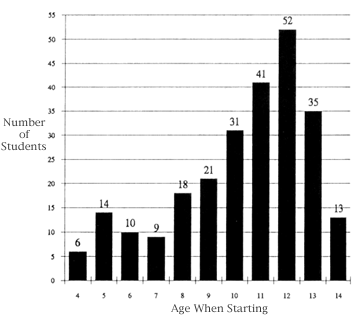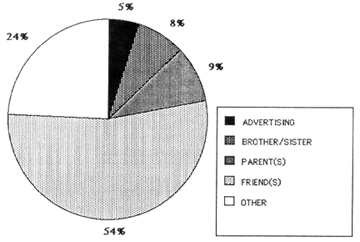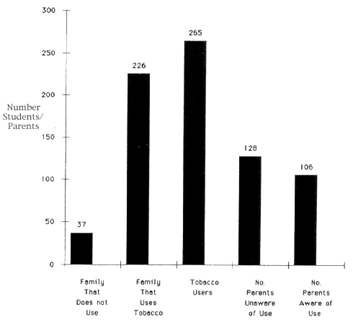Summer 1992 // Volume 30 // Number 2 // Feature Articles // 2FEA10
Tobacco Risk Awareness
Abstract
The fact the average for starting tobacco and substance abuse is 11 years for at-risk children underscores the need for collaboration among the schools and youth organizations to tackle the problem. These concerns led the Ohio Cooperative Extension Service to develop a tobacco use prevention program as part of its programming for at-risk youth.
One of the most popular and successful consumer products in the history of American business has also become one of the nation's most serious health risks. More than 80% of people who use tobacco products wish they could stop, or wish they had never started.1 The fact the average age for starting tobacco and substance abuse is 11 years for at-risk children underscores the need for collaboration among the schools and youth organizations to tackle the problem. In many cases, children step over an invisible line when they experiment with tobacco. Tobacco use by adolescents is related to using other chemicals because nicotine addiction may step up their use of other drugs. For that reason, tobacco is considered a "gateway drug" to substance abuse.2 Even those youth who don't become substance abusers risk cancer and heart and lung disease by smoking. These concerns led the Ohio Cooperative Extension Service to develop a tobacco use prevention program as part of its programming for at-risk youth.
Why Tobacco Education?
The use of tobacco products is becoming increasingly common among youth. For example, data from one county in southeast Ohio indicated that in several high schools more than 70% of the students used tobacco products.3 Children have little or no knowledge about the long-term health consequences of its use. Yet, the tobacco industry spends more than three billion dollars a year to promote its products4 and directs a large portion of its promotion and advertising campaigns toward young people. As youth educators, Extension faculty can be involved in the prevention of potentially harmful behaviors through tobacco education.
Tobacco Risk Awareness Program
In 1990, a comprehensive tobacco awareness curriculum for elementary teachers was developed by the Ohio State University Cooperative Extension Service. The Tobacco Risk Awareness Program, or TRAP, offers a manual with 26 lesson plans and classroom activities for grades two through six. The program incorporates visual and teaching aids to show how an early prevention program on tobacco helps increase the child's ability to make sound intellectual, physical, and social decisions. The 89-page curriculum manual details an educational program for youth educators to follow in helping primary age students develop positive health attitudes toward the nonuse of tobacco products. Easy-to-follow, one-to-three-page lesson plans incorporate tobacco education into the curriculum areas of health, science, music, language arts, and spelling, as well as the life skill areas of decision making and self-awareness. TRAP has been successfully pilot-tested by the Ohio Cooperative Extension Service 4-H staff in Jackson County school systems, with more than 1,500 students involved.
The tobacco risk awareness program in Jackson County was implemented through the cooperative effort of the County Health Department, Extension, and the public school system. The County Health Department provided funds for the county Extension office to hire a part-time professional teacher to work with the district 4-H specialist in developing, designing, and implementing the program in local schools. The health department also helped pay for printing materials and purchasing educational visual aids. The professional teacher trained more than 40 teachers in using the TRAP materials. Concern over student lifestyles and youth issues has motivated many other teachers throughout the county to also adopt the curriculum.
Program Evaluation
Two important components of the TRAP program were a tobacco use survey and measuring knowledge gained through a pre-post test. The survey was completed by 637 students in grades seven and eight. It collected information about the use of tobacco products and the knowledge students had about the effects of tobacco products on their health.
Forty-two percent, or 265 students, acknowledged they used tobacco products in some form. Twenty students in the user group reported starting at age four or five (see Figure 1). Fifty-four percent of the youth surveyed indicated friends had the greatest influence on their use of tobacco products (see Figure 2). The data also demonstrated a strong family influence. Of the 265 tobacco users, 85% had family members who also used tobacco products (see Figure 3). In a majority of cases, family members were aware of the youngster's tobacco use. The program coordinator also observed a great number of the parents who used smokeless tobacco tended to allow their male children to also use this product starting at a very early age. The pre-post testing results indicated an increase in knowledge concerning tobacco usage and the dangers involved. Based on the success of the program, the County Health Department has allocated funds for Extension to continue program implementation for 1991-92.

Figure 1. Starting age and number of students using tobacco products.

Figure 2. What influenced you to use tobacco?

Figure 3. Family influence on tobacco use.
The continuation of TRAP will enable educators to collect further data and provide more information on how cooperative early prevention programs can help reduce tobacco use among youth.
Footnotes
1. U.S., Department of Health and Human Services, Smoking, Tobacco, and Cancer Program, 1985-1989 Status Report (Washington, D.C.: Public Health Service, National Institutes of Health, National Cancer Institute, September 1990), pp. 51-66.
2. Jack Henningfield, "Smokeless Tobacco: Addictive, and a Gateway Drug," British Journal of Addiction, LXXXV (1990), 282.
3. Lucinda Miller, 1991 Scioto County Annual Report (Columbus, Ohio: Ohio Cooperative Extension Service, December 1991), p. 28.
4. Health vs Tobacco (Winter 1991). This is a quarterly publication produced by the Ohio Tobacco Risk Reduction Program, Bureau of Chronic Diseases, Ohio Department of Health, Columbus, Ohio.
